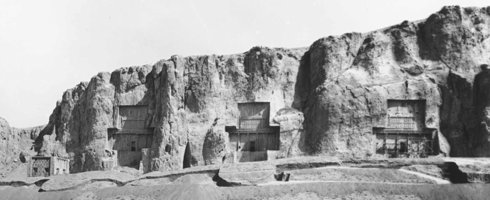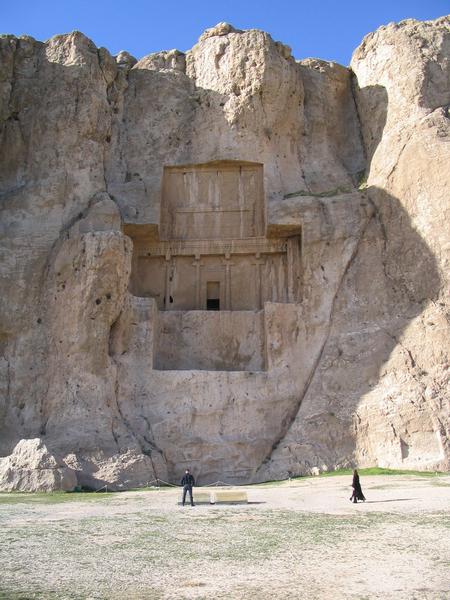
 |
Freethought & Rationalism ArchiveThe archives are read only. |
|
|
#1 |
|
Senior Member
Join Date: Mar 2007
Location: Texas
Posts: 976
|
EZRA 6:14 And the older men of the Jews were building and making progress under the prophesying of Hag´gai the prophet and Zech·a·ri´ah the grandson of Id´do, and they built and finished [it] due to the order of the God of Israel and due to the order of Cyrus and Da·ri´us and Ar·ta·xerx´es the king of Persia. 15 And they completed this house by the third day of the lunar month A´dar, that is, in the sixth year of the reign of Da·ri´us the king.
The above is a wonderful example of concise chronology. It tells us the accession year of Artaxerxes was year six of Darius. This also means Darius only ruled for 6 years. Current popular chronology assigns him 36 years, so there is a contradiction. It means that his history was revised by the Persians and expanded. Because this was a government-sponsored revision, actual records supporting the fake 7-36 years of the rule of Darius are suspect. Instead we look to other evidence that might or might not confirm he ruled that long. Persepolis is a city begun by Darius and when we go there for critical evidence, aside from the inscriptions, we find a quick confirmation of his short rule. http://www.iranchamber.com/history/p...ersepolis1.php First of all, Persepolis is called a "city" but it's more like a royal compound of about 11 buildings primarily meeting halls, palaces, a Treasury and Harem.  Now it is known that Darius started several buildings here but only was barely able to finish his own palace. Palaces elsewhere in Persia were completed in about two years. Building records from Persepolis indicate it was begun in the 4th year of the king building it, which could only be Darius I. Yet he was barely able to finish his palace. One inscription there says Darius built it and another says Xerxes completed it. After that he died and the several other buildings that were started by Darius at Persepolis had to be completed by Xerxes. PROBLEM: If he began to build his palace in his 4th year, and they only took two years to build, then why wasn't he able to finish it? If we take the history for face value, it would seem, therefore, he started a palace in his 4th year and it was still under construction for the next 32 years and still left uncompleted, obliging his son Xerxes to complete it. Sorry, not likely. Instead, if we follow the Bible, the building records record correctly Persepolis was begun in the 4th year of Darius but due to his untimely death at Marathon, beheaded by a Greek woman whom he saw privately, he died in his 6th, just as he was completing this palace. The fact that Darius was unable to finish a 2-year palace begun in his 4th year indicates he died within 2 years of beginning the project. Of course, his son and co-ruler, Xerxes, was already involved with the building there and promptly finished the buildings there. Of note, though, when he became sole ruler, he adopted the name of "Artaxerxes." Thus the Throne Hall though begun by Darius and Xerxes is shown as being completed by "Artaxerxes". This is more evidence that Xerxes merely added a name and that Xerxes and Artaxerxes are the same king. I say "added" because there are astronomical texts dated to up to year 27 of a king Artaxerxes who is "also known as ARSES (Xerxes)." But all the alternative names are known for the other two Artaxerxes: Artaxerxes II was "Mneumon," and Artaxerxes III was "Nothus." That leaves Artaxerxes I as "Xerxes." So it was not a name change, but a name addition. But this was not well known to the Greeks, and so Xerxes used this to claim the Artaxerxes ruling was a different person, Xerxes' son. Darius also prebuilt three tombs at Naqshi-Rustam. He is buried in the tomb #1, but "Artaxerxes" is buried in tomb #2, and Darius I in tomb #3. Of course, there's no problem with this since Xerxes was Artaxerxes and so he is buried in the right tomb. But to cover up the conspiracy and fool the Greeks, another tomb was later placed there for "Xerxes", but it is newer and so new a different sculptor could only copy the artwork from the earlier three tombs. The added tomb is lower and facing another direction than the original three.  Also, Nehemiah is present with Xerxes and Darius proving he was already the cupbearer early in the reign of Darius I. He lived through the reign of Darius I, Artaxerxes I and into the reign of Darius II. With the additional expanded history he would have had to have lived over 143 years of age. When Darius dies at 6 years and no extra 21-year rule given to Xerxes, then Nehemiah easily survies past the rule of Artaxerxes/Xerxes. Xerxes was born the year Cyrus became king. If Nehemiah, who returned from Babylon this year was about 30 years of age, he would have been only 89 when Artaxerxes/Xerxes died 59 years later. Nehemiah with Darius and Xerxes Of course, archaeologists avoid Persepolis like a plague. Far too many questions!! Larsguy47 |
|
|
|
|
#2 |
|
Senior Member
Join Date: Mar 2007
Location: 36078
Posts: 849
|
Just a quick look around tells me that you've confused the "Darius the Mede" " son of Ahasuerus" mentioned in the Bible with Darius the Great, a Persian emperor.
Biblical "Darius the Mede" hasn't been established as an actual person of history outside the Bible's claim. Besides that, the verse And they completed this house by the third day of the lunar month A´dar, that is, in the sixth year of the reign of Da·ri´us the king. does not establish that Darius the Mede ruled for only six years. The verse simply does not say that. |
|
|
|
|
#3 | ||||||||
|
Regular Member
Join Date: Jan 2007
Location: Canada
Posts: 363
|
Quote:
From your own article: Quote:
Also, from your article: Quote:
Quote:
Persepolis Quote:
Naqš-i Rustam Quote:
Tomb 2:  Tomb 3:  Tomb 4:  Quote:
Quote:
Peace |
||||||||
|
|
|
|
#4 |
|
Veteran Member
Join Date: Jul 2003
Location: San Francisco
Posts: 3,283
|
Not again...
|
|
|
|
|
#5 |
|
Junior Member
Join Date: Mar 2007
Location: Chicago
Posts: 38
|
Are you trying to prove that the writer of Ezra Chapters 4 and 5 was on crack?
|
|
|
|
|
#6 |
|
Contributor
Join Date: Mar 2002
Location: nowhere
Posts: 15,747
|
My oh my, what does one take for logorrhea?
Umm, did one ever think of reading what the kings have to say for themselves? Artaxerxes II gave his own genealogy: son of Darius the king, of Darius son of Artaxerxes the king, of Artaxerxes son of Xerxes the king, of Xerxes son of Darius the king, of Darius son of Hystaspes, an AchaemenianThis is the sort of thing that was planted in public view around the Persian empire. The particular example was from Susa. At Persepolis Artaxerxes I -- the one that Larsguy47 wants not to have existed -- wrote on a block found at Persepolis that he was: son of Xerxes the King, grandson of Darius, an AchaemenianDarius I himself says in the first column of the Behistun inscription: My father was Hystaspes; Hystaspes' father was Arsames; Arsames' father was Ariaramnes; Ariaramnes' father was Teispes; Teispes' father was Achaemenes.To ignore all of this we get quotes from historically unvetted biblical works intermingled with more numerical spaghetti thinking. The only person who thinks that Artaxerxes I and Xerxes I were the same person is the one who seems unaware of the available evidence. Worse still he doesn't understand his text of Ezra. When he gets to Ezra 6:14 he didn't notice that there were five chapters before that. He doesn't notice
This, omitting the truly minor kings, is the order of Persian kings from Cyrus to Artaxerxes II. Larsguy47 has simply goofed -- badly. spin |
|
|
|
|
#7 | |||
|
Senior Member
Join Date: Mar 2007
Location: Texas
Posts: 976
|
Quote:
Here's the last part of his fasinating "A Short Chronicle": Quote:
Further his character is generally identified in Herodotus as Cyaxares, the king who conquered Babylon with Cyrus. So he's definitely there and prominent in history, just suppressed because his 6-year rule along with 20 years from other kings was taken from the NB kings in order to cover for the expanded rulership of Darius I, who went from 6 to 36 years. Quote:
Larsguy47 |
|||
|
|
|
|
#8 |
|
Contributor
Join Date: Mar 2004
Location: Dallas, TX
Posts: 11,525
|
|
|
|
|
|
#9 |
|
Banned
Join Date: Oct 2002
Location: NYC
Posts: 10,532
|
Larsguy47, how about a scholarly source concerning Darius the Mede later than Isaac Newton (1722)? This does not count as a source as you don't have Newton's sources.
No scholar has ever been able to identify such a figure? You might start here: http://en.wikipedia.org/wiki/Book_of...us_the_Mede.22 RED DAVE |
|
|
|
|
#10 | ||||||||
|
Veteran Member
Join Date: Jan 2001
Location: In the dark places of the world
Posts: 8,093
|
Quote:
Quote:
Quote:
Complete with alternate name - the same one you said wasn't known for Artaxerxes I. Quote:
Quote:
Quote:
Quote:
http://www.livius.org/ct-cz/cyrus_I/...der2.html#TEXT Quote:
|
||||||||
|
|
| Thread Tools | Search this Thread |
|